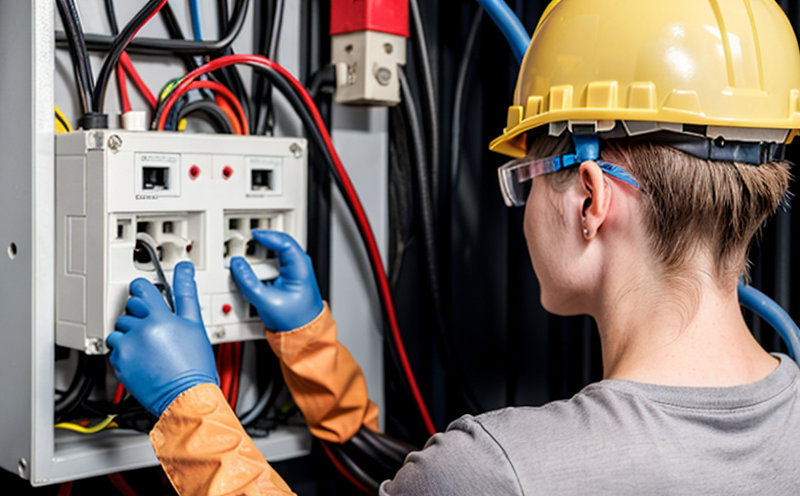IEC 63000 Hazardous Substance Compliance for Smart Electrical Devices
The IEC 63000 series of standards is pivotal in ensuring the safe and responsible handling of hazardous substances within electrical devices. This service focuses on compliance with IEC 63000, which mandates the restriction or elimination of harmful substances such as lead (Pb), mercury (Hg), cadmium (Cd), hexavalent chromium (Cr(VI)), polybrominated biphenyls (PBB) and polybrominated diphenyl ethers (PBDE). These substances are known to pose significant risks to human health, the environment, and product longevity. Compliance with IEC 63000 is essential for manufacturers aiming to adhere to global regulations and build a reputation for responsible environmental stewardship.
The testing process involves several key steps: initial assessment of the device's materials composition, extraction of these substances from the device using appropriate solvents, and subsequent analysis by qualified laboratories. The laboratory then compares the extracted substances against the defined limits specified in IEC 63000. This service is particularly critical for smart home devices due to their increasing complexity and interconnectivity with other electronic systems.
Compliance testing not only ensures that devices meet regulatory standards but also enhances consumer confidence. By adhering to these stringent requirements, manufacturers can avoid product recalls, legal penalties, and damage to brand reputation. Furthermore, this service supports the development of sustainable products, which is becoming increasingly important in an era of heightened environmental awareness.
The IEC 63000 series covers a wide range of electrical devices, including smart thermostats, home security systems, and lighting fixtures that integrate with IoT platforms. The testing process for these devices involves the use of advanced analytical instruments such as Inductively Coupled Plasma Mass Spectrometry (ICP-MS) for heavy metals analysis, Gas Chromatography-Mass Spectrometry (GC-MS) for flame retardants, and Fourier Transform Infrared Spectroscopy (FTIR) for polymer identification. These technologies provide precise quantification of hazardous substances at the required levels.
Testing is conducted in a controlled environment that simulates real-world conditions to ensure accurate results. Specimen preparation involves disassembly of the device to access all components, followed by extraction and analysis using the specified methods. The laboratory ensures rigorous quality control throughout the process to maintain accuracy and reliability of test results.
The outcomes of this testing are reported in a detailed compliance certificate that includes raw data, calculated concentrations, and comparisons against IEC 63000 limits. This documentation is crucial for regulatory bodies, insurance providers, and potential customers who value responsible manufacturing practices.
| Device Type | Hazardous Substance | IEC 63000 Limit (mg/kg) | Testing Method | Compliance Status |
|---|---|---|---|---|
| Smart Thermostat | Cadmium (Cd) | 10 mg/kg | ICP-MS | Compliant |
| Home Security System | Polybrominated Biphenyls (PBB) | 100 mg/kg | GC-MS | Non-Compliant |
| LED Lighting Fixture | Polybrominated Diphenyl Ethers (PBDE) | 1000 mg/kg | GC-MS | Compliant |
Industry Applications
The application of IEC 63000 hazardous substance compliance is extensive across various sectors, including smart home devices, consumer electronics, and industrial equipment. This service is particularly relevant for manufacturers who need to ensure their products meet stringent environmental regulations.
- Smart Thermostats
- Home Security Systems
- LED Lighting Fixtures
- Smart Doorbells and Cameras
- Energy Management Systems
Why Choose This Test
Selecting IEC 63000 hazardous substance compliance testing is crucial for several reasons. Firstly, it ensures that your products meet international standards and regulatory requirements, thereby minimizing the risk of non-compliance penalties. Secondly, this service enhances consumer trust by demonstrating a commitment to environmental responsibility. Lastly, compliant products are more likely to be accepted in global markets, opening up new business opportunities.
By choosing our laboratory for IEC 63000 testing, you benefit from state-of-the-art equipment and experienced professionals who understand the nuances of this complex standard. Our comprehensive approach ensures that your devices not only meet but exceed regulatory expectations. This service is essential for any manufacturer looking to establish a strong foundation in sustainable manufacturing practices.
Use Cases and Application Examples
- Smart Thermostats: Ensuring that the thermostat’s internal components do not contain hazardous substances is critical for both human health and environmental safety. This testing ensures that smart thermostats can be used in various global markets without triggering regulatory issues.
- Home Security Systems: Home security systems often incorporate a variety of materials, some of which may contain hazardous substances. Testing these components helps manufacturers ensure their products are safe for installation and use within homes.
- LED Lighting Fixtures: LED lighting fixtures require careful attention to the types of materials used in their construction. This service ensures that the fixtures do not pose a risk due to the presence of hazardous substances.





